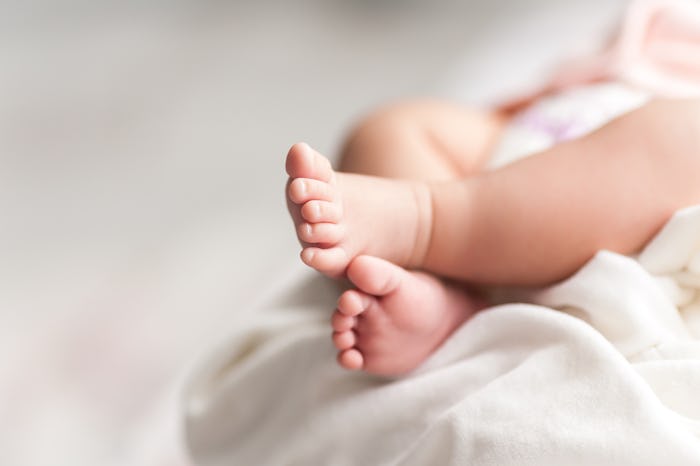Life
Here's What You Need To Know If Your Baby's Feet Seem Like They're Always Cold
Are you one of those people who constantly has cold hands and feet? Some unfortunate souls are just like that. I'm one of them, and while it doesn't usually bother me, it's something I definitely notice. But what if it happens to your baby? Like most parents, you probably get a little concerned if your baby's feet are cold. Is it something to worry about or is it completely harmless? As moms, we can't help ourselves when it comes to being hyper-aware of every baby body part and its function... but some of the things we notice are no big deal. I consulted pediatrician Daniel Ganjian, M.D., to find out whether cold feet in babies are a problem or not.
As it turns out, cold feet in babies are often purple feet, too. Shocking as purple feet can be, however, Dr. Ganjian tells Romper in an email that "babies can have bluish-purple feet and hands as a result of their immature circulatory systems causing a delay in blood movement to the extremities." This circulation issue doesn't just make your baby's feet look purple, either; it can make them feel cold as well.
Still, normal or not, Dr. Ganjian advises moms to make sure there isn't anything visible that's causing the decreased circulation, such as pieces of string or jewelry that might have twisted around your baby's ankles or toes preventing proper blood flow.
"As long as the child is not blue or cold in other places — such as the face, lips, tongue, chest — then cold feet are completely harmless," Dr. Ganjian says. .
In fact, your baby might not even be cold anywhere but his feet! As a Parents article reported, as long as your baby's torso is warm, she isn't feeling chilled. The same article explains that "because [your baby's] circulatory system is still developing, blood is shunted more often to vital organs and systems, where it's needed most. His hands and feet are the last body parts to get a good blood supply. It can take up to three months for his circulation to adapt completely to life outside the womb." So don't worry moms, those cold feet should go away with age.
If they don't, though, or you're still concerned, Dr. Ganjian, says to seek medical attention if your baby's cold feet are "accompanied by bluish skin around other sites of the body." If this happening, doctors will need to check your baby's heart and lung function, as well as oxygen levels. Trust your gut and if something seems off, don't hesitate to call your doctor. Since babies can't verbalize what they're feeling, it's always best to be safe than sorry.
After you've determined your baby's cold feet are completely normal and harmless, there are some tips to help them feel a little more comfortable. While there is no way to prevent your baby from getting cold feet in the first place — aside from keeping their feet covered with warms socks or a blanket — there are some solutions to help aid in their new circulatory function.
Massaging the feet and legs to improve blood flow or using mild warm packs are two methods suggested by Dr. Ganjian, as doctors actually use these warm packs in the hospital specifically on baby feet to help draw blood. Another great tip is to keep clothes nearby when changing your child. The less time your baby spends naked, the lower the chances of cold feet. Overall, keeping your baby clothed and dressed appropriately for the weather is all you need to do in most cases. (Good luck keeping those socks on!)
